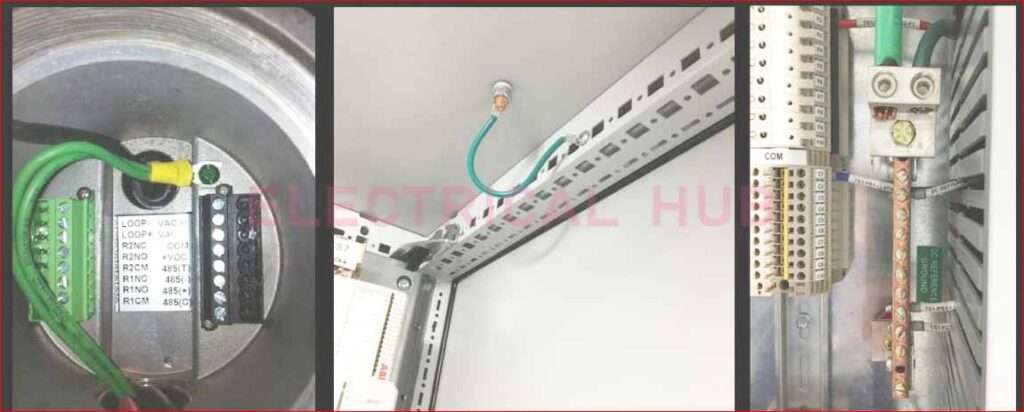Bonded and Grounded: Basics of Bonding and Grounding
In the world of electrical systems, the terms bonded and grounded often come up. These concepts are fundamental to electrical safety, yet they are frequently misunderstood. Understanding the difference between bonding and grounding; and how they work together. It can help ensure safety, functionality, and compliance with standards like NEC and IEC.

In this article, we’ll explore the meaning of bonded and grounded, and explore the differences between bonding and grounding. Let’s start with the basics.
Table of Contents
Table of Contents
What Does Bonded and Grounded Mean?
Bonded and grounded are terms used to describe safety measures in electrical systems. While they work hand-in-hand, each serves a unique purpose.
Bonding and Grounding: A Simplified Explanation
- Grounding involves connecting an electrical system to the earth. This prevents dangerous voltage levels in case of a fault.
- Bonding connects all metallic parts of an electrical system to ensure they have the same electrical potential. This minimizes the risk of electrical shock.

When systems are properly bonded and grounded, they offer protection against electrical faults, such as short circuits or lightning strikes.
Bonded and Grounded: Why It Matters
Electrical systems are complex, and without proper grounding and bonding, the risks of fire, equipment damage, or electrocution increase dramatically. Grounding ensures fault currents safely dissipate into the earth, while bonding eliminates potential differences between conductive parts.
For instance, in aviation, bonding and grounding are crucial to prevent static discharge during refueling. Similarly, in industrial settings, grounding and bonding protect sensitive equipment and maintain safe working conditions.
Bonded vs Grounded: What’s the Difference?
The terms bonded and grounded are sometimes used interchangeably, but they have distinct meanings. Let’s break it down:
Grounding
- Purpose: To direct fault currents into the earth.
- Key Components: Ground rods, grounding electrode conductors (refer to NEC 250.66 Table for sizes), and earth connections.
- Example: A residential system grounded with a copper rod ensures fault currents have a safe path.
Bonding
- Purpose: To connect all metallic components and ensure equal electrical potential.
- Key Components: Bonding jumpers and conductors.
- Example: Metal water pipes and gas lines bonded to an electrical panel reduce shock risks.

How Bonding and Grounding Work Together
Bonding and grounding are like two sides of the same coin. Grounding provides a path for electrical energy to flow into the earth, while bonding connects all metallic parts to prevent voltage differences.
For example, in a commercial building, grounding protects against surges, while bonding ensures exposed metal parts do not become hazardous during a fault.
Applications of Bonding and Grounding
Residential Systems
Proper grounding and bonding in homes ensure safety from lightning strikes and power surges. Systems like the minimum earthing conductor size and earthing cable size calculation formula help electricians determine the right setup.
Industrial Systems
Grounding and bonding are vital in industrial environments to protect equipment and workers. For instance, using the IEC Standard for Instrument Earthing ensures compliance and safety.
Aviation
In aviation, grounding and bonding prevent static buildup, which could ignite fuel vapors during refueling.
Frequently Asked Questions: Bonding and Grounding
What is the Difference Between Earthed and Bonded?
Earthed refers to connecting a system to the earth, while bonded connects metallic parts to ensure no voltage differences exist.
Which is More Important, Grounding or Bonding?
Both are equally important. Grounding protects against surges, while bonding prevents shock hazards.
What is the Difference Between Grounded and Earthed?
In the U.S., “grounded” and “earthed” mean the same thing—connecting a system to the earth.
What is the Difference Between Bonding and Grounding in Aviation?
In aviation, bonding prevents static electricity buildup, while grounding provides a safe discharge path for electrical currents.
What Does Bonded and Grounded Mean?
It means a system is electrically safe, with proper connections to the earth (grounding) and between metallic parts (bonding).
What Exactly is Grounding?
Grounding connects electrical systems to the earth, providing a safe path for fault currents.
Why are Ground and Neutral Bonded?
Bonding ground and neutral ensures fault currents return to the source, improving safety.
What is the Principle of Grounding?
The principle of grounding is to provide a low-resistance path for fault currents to safely dissipate into the earth.
How Do You Test Bonding and Grounding?
Testing involves checking connections with a multimeter and verifying resistance levels.
How to Check Earthing?
You can check earthing by measuring resistance using an earth tester. Low resistance indicates effective earthing.
What is the Difference Between Grounded and Not Grounded?
Grounded systems are connected to the earth, ensuring safety. Non-grounded systems lack this connection, posing higher risks.
What are the Two Types of Earthing?
- Pipe Earthing
- Plate Earthing
Choosing the Right Grounding and Bonding System
Proper grounding and bonding start with selecting the right components. For instance, consulting the NEC 250.66 Table helps determine the grounding electrode conductor size. Similarly, standards like the IEC Standard for Instrument Earthing provide guidelines for industrial systems.
Conclusion: Staying Bonded and Grounded
Understanding the difference between bonded and grounded systems can save lives and protect equipment. Whether it’s a residential setup or a commercial installation, ensuring proper bonding and grounding is non-negotiable.
By following standards, conducting regular tests, and understanding the principles, you can create safe, efficient electrical systems.
For more detailed guides, check out related posts on topics like the Size of Earth Wire, Earthing Cable Size Standard, and Earthing Cable Size as Per IEC.
Follow Us on Social:
Subscribe our Newsletter on Electrical Insights to get the latest updates in Electrical Engineering.
#BondingAndGrounding, #ElectricalSafety, #GroundingBasics, #BondingBasics, #ElectricalEngineering, #SafetyFirst, #GroundingAndBonding, #ElectricalWiring, #ElectricalStandards, #BondedAndGrounded, #Electricity101, #SafetyTips, #ElectricalSystems, #GroundingImportance, #HomeElectricalSafety
